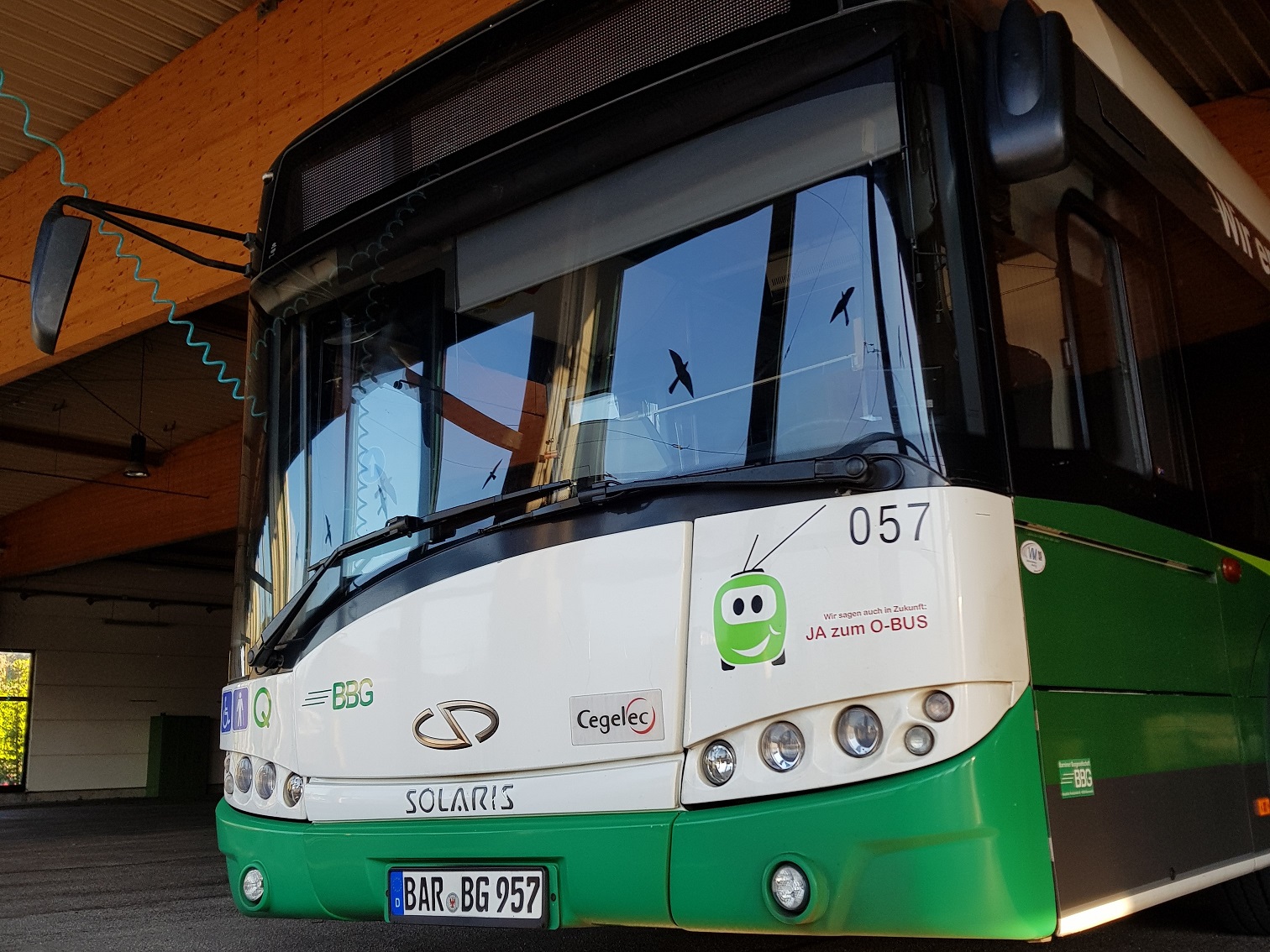Barnimer Busgesellschaft - Carbon-free buses for Eberswalde

Climate protection and sustainable development are making the trolleybus, or ‘O-bus’ as it is affectionately called in Eberswalde, an interesting option for the future. Just like with trams, the overhead lines supply the electricity needed to run the trolleybus. With a new battery, the bus can now also run carbon-free independent of the lines.
The trolleybus is considered to be the most important means of public transport in the city of Eberswalde and has been commuting on the same routes of the ‘861 Nordend’ and ‘862 Ostend’ city lines since 1940. The network of overhead lines criss-crosses the city over a distance of close to 26 kilometres. The trolleybus fleet operated by Barnimer Busgesellschaft covers around 250,000 kilometres per year, transporting around 4.2 million passengers. This means that every person in Eberswalde boards one of the electrically powered articulated buses more than a hundred times a year.
New electric drive for detours
Up to now, Eberswalde‘s trolleybuses had to resort to an emergency drive with a diesel generator for detour routes around roadworks. In order to facilitate emission-free operations powered by electricity in situations like these, funding has been provided for new battery packs for the trolleybuses, for instance, by the European Regional Development Fund (ERDF).
To achieve emission-free mobility in Eberswalde, Barnimer Busgesellschaft will equip the entire trolleybus fleet with state-of-the-art, powerful battery packs that recharge themselves during normal operation and supply the bus with electricity when the overhead line is temporarily unavailable. This conversion, carried out by the bus operator itself, was scientifically monitored by Technische Universität Dresden and Fraunhofer Institute IVI from Dresden and implemented in cooperation with vehicle manufacturer Solaris and electrical equipment supplier Cegelec. A trolleybus upgraded in this way can cover up to 16 kilometres while travelling ‘topless’. The conversion cost about EUR 140,000 per vehicle. By the end of 2021, the fleet will have been fully converted and will also be used in regular services outside the city limits.
Driving 100 % emission-free into the future
The idea to part with the old transport system had been around for some time. An expert opinion at the beginning of the noughties suggested switching to other systems, but the conversion proved to be more expensive than the continued use of the trolleybus. The decision by the Barnim district, as the owner of the Barnimer Busgesellschaft, to maintain the trolleybus system makes Eberswalde a pioneer in low-carbon public transport and electric mobility in Germany.
Managing Director Frank Wruck of Barnimer Busgesellschaft puts it in a nutshell: “The conversion showed us that the trolleybus can certainly be a future-oriented solution for local public transport.” Eberswalde could very well become a sustainable model for other cities in Germany and Europe.
For further information, visit bbg-eberswalde.de
The trolleybus is considered to be the most important means of public transport in the city of Eberswalde and has been commuting on the same routes of the ‘861 Nordend’ and ‘862 Ostend’ city lines since 1940. The network of overhead lines criss-crosses the city over a distance of close to 26 kilometres. The trolleybus fleet operated by Barnimer Busgesellschaft covers around 250,000 kilometres per year, transporting around 4.2 million passengers. This means that every person in Eberswalde boards one of the electrically powered articulated buses more than a hundred times a year.
New electric drive for detours
Up to now, Eberswalde‘s trolleybuses had to resort to an emergency drive with a diesel generator for detour routes around roadworks. In order to facilitate emission-free operations powered by electricity in situations like these, funding has been provided for new battery packs for the trolleybuses, for instance, by the European Regional Development Fund (ERDF).
To achieve emission-free mobility in Eberswalde, Barnimer Busgesellschaft will equip the entire trolleybus fleet with state-of-the-art, powerful battery packs that recharge themselves during normal operation and supply the bus with electricity when the overhead line is temporarily unavailable. This conversion, carried out by the bus operator itself, was scientifically monitored by Technische Universität Dresden and Fraunhofer Institute IVI from Dresden and implemented in cooperation with vehicle manufacturer Solaris and electrical equipment supplier Cegelec. A trolleybus upgraded in this way can cover up to 16 kilometres while travelling ‘topless’. The conversion cost about EUR 140,000 per vehicle. By the end of 2021, the fleet will have been fully converted and will also be used in regular services outside the city limits.
Driving 100 % emission-free into the future
The idea to part with the old transport system had been around for some time. An expert opinion at the beginning of the noughties suggested switching to other systems, but the conversion proved to be more expensive than the continued use of the trolleybus. The decision by the Barnim district, as the owner of the Barnimer Busgesellschaft, to maintain the trolleybus system makes Eberswalde a pioneer in low-carbon public transport and electric mobility in Germany.
Managing Director Frank Wruck of Barnimer Busgesellschaft puts it in a nutshell: “The conversion showed us that the trolleybus can certainly be a future-oriented solution for local public transport.” Eberswalde could very well become a sustainable model for other cities in Germany and Europe.
For further information, visit bbg-eberswalde.de

